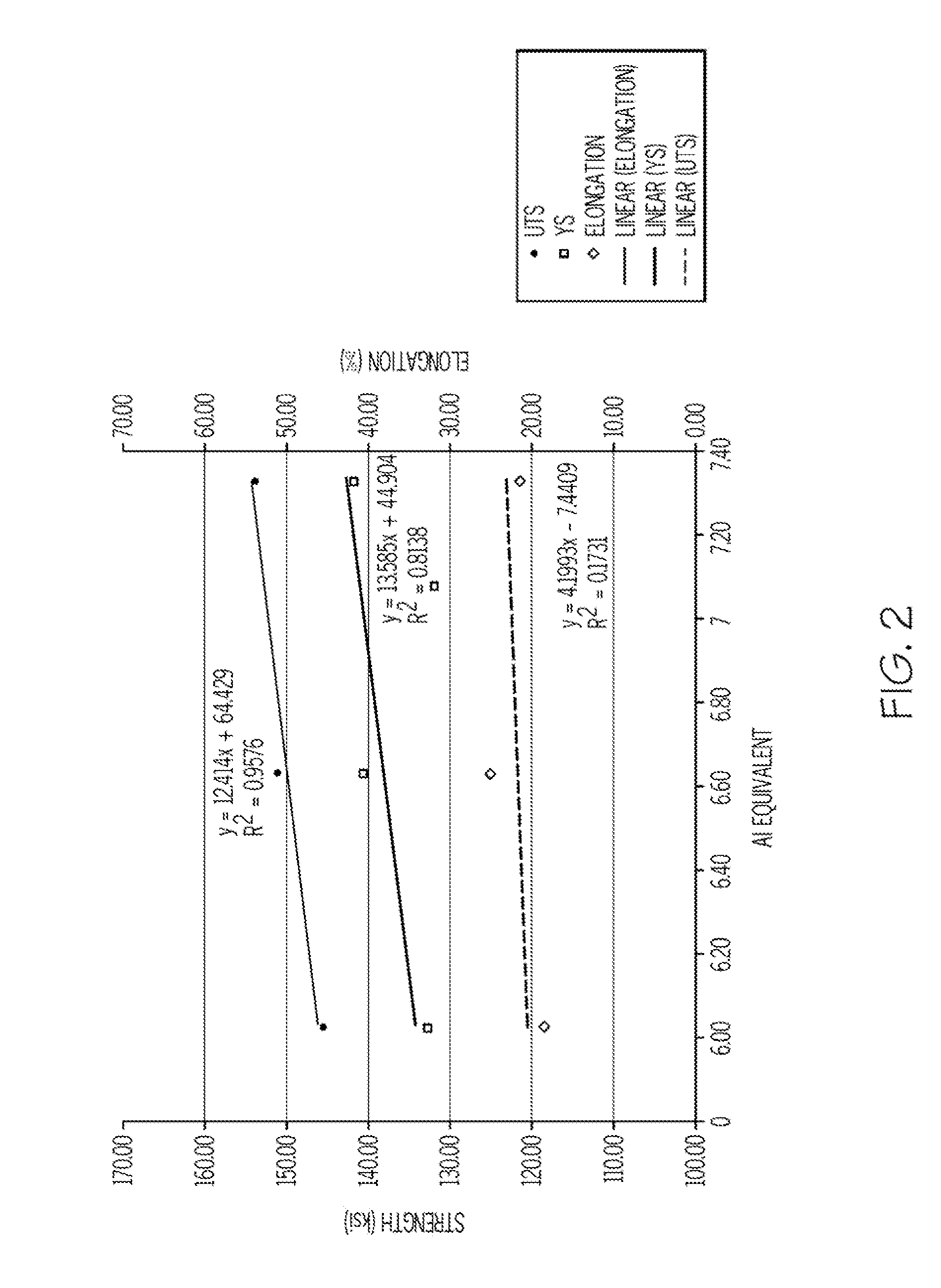High strength alpha/beta titanium alloy
- Summary
- Abstract
- Description
- Claims
- Application Information
AI Technical Summary
Problems solved by technology
Method used
Image
Examples
example 1
[0060]Alpha / beta titanium alloy ingots having a composition according to the present disclosure were cast using conventional vacuum arc remelting (VAR), plasma arc melting (PAM), or electron beam cold hearth melting (EB) for primary melting, and were remelted using VAR. The compositions of the ingots were within the ranges listed in the “Non-Limiting Embodiments according to the Present Disclosure” column includes in Table 1 above.
[0061]The ingot compositions produced in this Example 1 had aluminum equivalent values ranging from about 6.0 to about 7.1. The ingots were processed using various hot rolling practices into hot rolled bars and wire having diameters between 0.25 inch (0.635 cm) and 3.25 inch (8.255 cm). Hot rolling was conducted at starting temperatures between 1550° F. (843.3° C.) and 1650° F. (898.9° C.). This temperature range is below the alpha / beta transus temperature of the alloys of this example, which is about 1750° F. to about 1850° F. (about 954.4° C. to about 10...
example 2
[0064]Wire sample nos. 9-11 from Example 1, having a diameter of 0.5 inch (1.27 cm) and aluminum equivalent values of about 6.5, about 6.8 and about 7.15, were tensile tested at room temperature. The results of the tensile tests are displayed graphically in FIG. 2. All of these samples exhibited tensile and yield strengths that are comparable to or higher than strengths exhibited by commercial Ti-6Al-4V alloy. As with FIG. 1, it is seen from FIG. 2 that increasing Aleq results in increased strength, along with an increase in average percent elongation. As discussed above, this trend is surprising and unexpected because it is counter to the generally observed relationship that increasing strength is accompanied by decreasing ductility. There is less scatter in the data of FIG. 2, which is representative of testing done on samples of the same size, as compared with FIG. 1, which is representative of testing done on samples of various sizes, because mechanical properties are influenced...
example 3
[0065]Hot rolled 1 inch (2.54 cm) thick plate samples were fabricated from ingots manufactured according to steps described in Example 1. The alloys ingots had compositions within the ranges listed in the “Non-Limiting Embodiments according to the Present Disclosure” column in Table 1 above, with aluminum and oxygen concentrations and aluminum equivalent values as listed in Table 3.
TABLE 3SampleDiameterAlFeOAleqNo.(in.)(wt. %)(wt. %)(wt. %)(Al % + 10 · O %)1814.081.530.246.431914.131.440.246.482014.221.490.297.122114.251.400.287.052214.211.380.297.08
[0066]All hot rolling temperatures were below the alpha / beta transus temperatures of the alloys. The alloys had Aleq values from about 6.5 to about 7.1. Room temperature tensile testing was used to determine tensile strength, yield strength, and percent elongation (ductility). The results of tensile testing are displayed graphically in FIG. 3. It is seen From FIG. 3 that alloys including increased levels of Al and O, as indicated by calc...
PUM
| Property | Measurement | Unit |
|---|---|---|
| Fraction | aaaaa | aaaaa |
| Fraction | aaaaa | aaaaa |
| Pressure | aaaaa | aaaaa |
Abstract
Description
Claims
Application Information
 Login to View More
Login to View More - R&D
- Intellectual Property
- Life Sciences
- Materials
- Tech Scout
- Unparalleled Data Quality
- Higher Quality Content
- 60% Fewer Hallucinations
Browse by: Latest US Patents, China's latest patents, Technical Efficacy Thesaurus, Application Domain, Technology Topic, Popular Technical Reports.
© 2025 PatSnap. All rights reserved.Legal|Privacy policy|Modern Slavery Act Transparency Statement|Sitemap|About US| Contact US: help@patsnap.com



